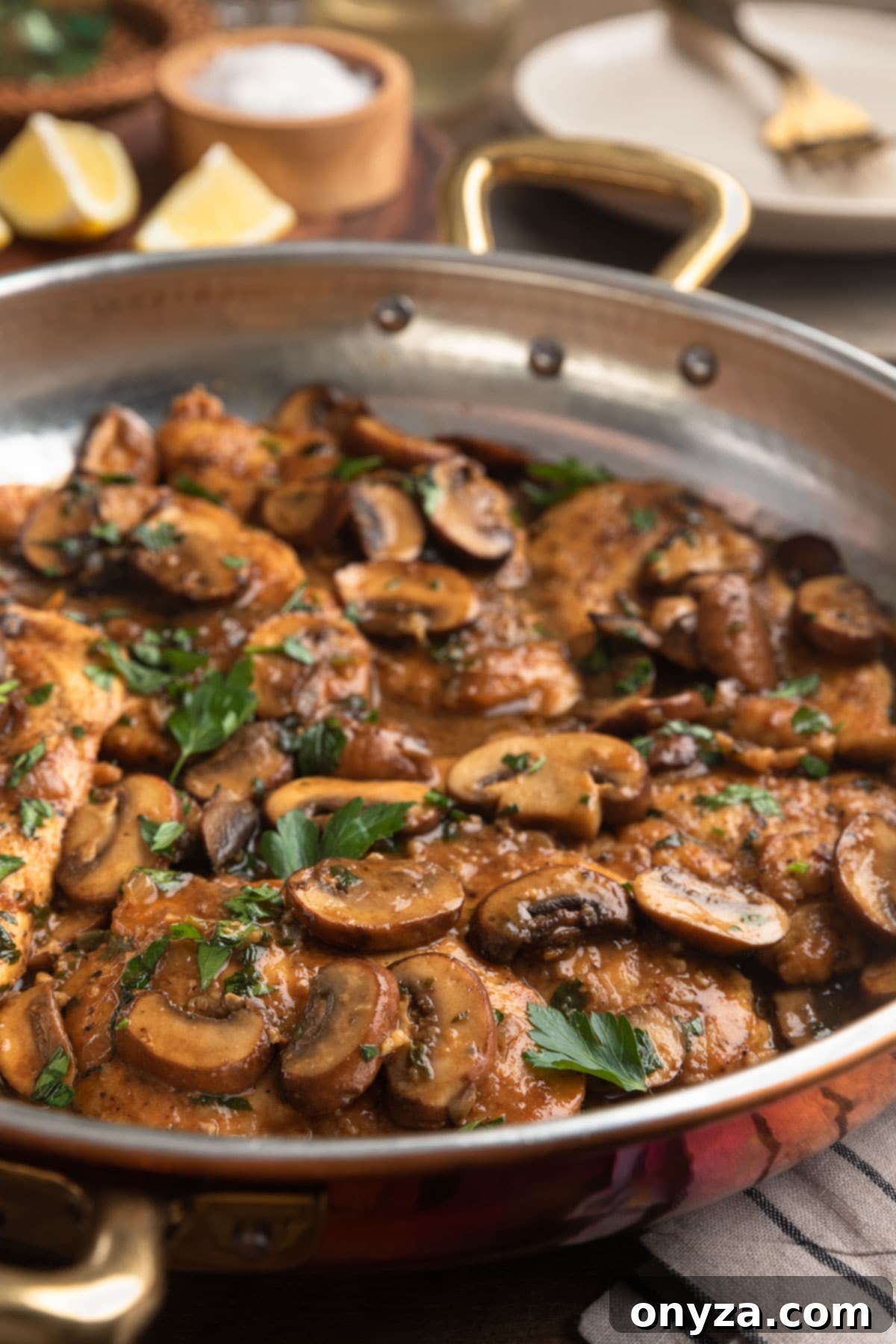Mastering Classic Chicken Marsala: A Guide to Italian-American Perfection
Experience the exquisite taste of Chicken Marsala, an iconic Italian-American dish that brings gourmet dining right to your kitchen. Renowned for its succulent chicken cutlets bathed in a rich, savory Marsala wine and mushroom sauce, this elegant meal is surprisingly simple to prepare and perfect for both weeknight dinners and special occasions. Discover the secrets to creating this restaurant-quality classic in just over an hour, from preparation to plate.
Craving more delicious Marsala-infused dishes? You might also enjoy our popular Creamy Pork Chops Marsala—a true reader favorite that shares the rich flavors of this beloved fortified wine.
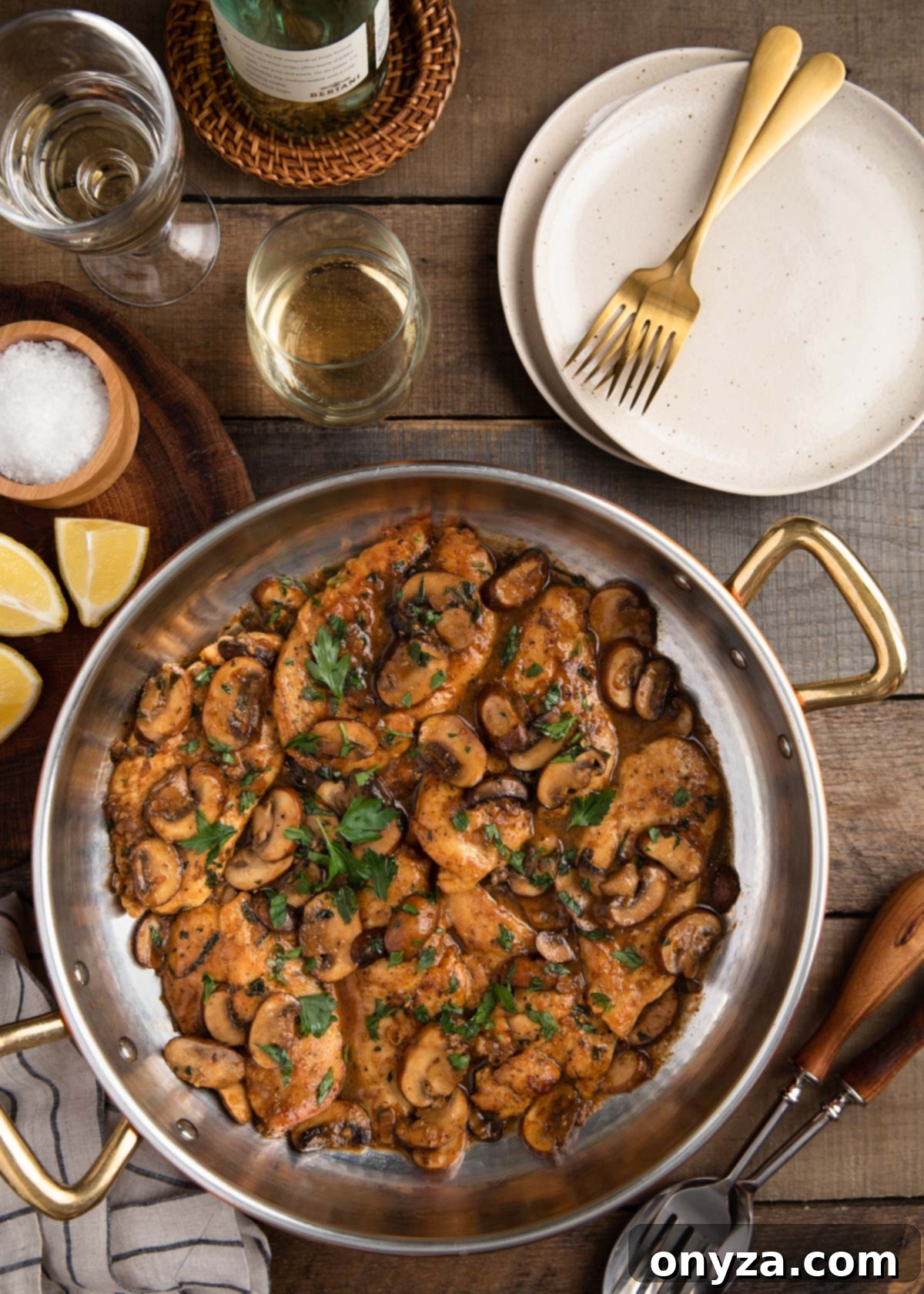
Essential Preparations: What You Need to Know Before You Cook
Embarking on your Chicken Marsala journey begins with understanding a few key components. The right ingredients and equipment can make all the difference in achieving that authentic, mouth-watering flavor and perfect texture.
- Selecting and Preparing Chicken Cutlets: For optimal tenderness and quick, even cooking, thin chicken cutlets are crucial. You can often find pre-sliced chicken breast cutlets, sometimes labeled “scallopini,” at your local grocery store, which will significantly reduce prep time. If starting with whole boneless, skinless chicken breasts, you’ll need to carefully slice them in half horizontally to create thinner fillets, then pound them to an even ¼-inch thickness. This ensures they cook quickly and uniformly, preventing dry, overcooked chicken.
- Choosing the Right Mushrooms: Mushrooms are integral to the earthy depth of Marsala sauce. While classic Chicken Marsala traditionally calls for white button or cremini (baby bella) mushrooms, cremini are often favored for their richer, more robust flavor profile. Don’t hesitate to experiment with other varieties like shiitake for added umami or even rehydrated dried porcini (with a splash of their soaking liquid) for an intensely savory note. Always purchase whole mushrooms and slice them just before cooking to maintain their freshness and texture.
- The Ideal Cooking Pan: A large, heavy-bottomed skillet or sauté pan, ideally 12 to 14 inches in diameter, is essential for this recipe. The generous surface area allows you to brown the chicken in batches without overcrowding, which is vital for achieving a beautiful golden crust rather than steaming the chicken. A good quality pan also ensures even heat distribution, preventing hot spots and promoting consistent cooking.
Choosing the Perfect Marsala Wine for Your Sauce
The distinctive flavor of Chicken Marsala comes directly from its namesake ingredient: Marsala wine. Originating from Sicily, Italy, Marsala is a fortified wine, meaning it’s been strengthened with a distilled spirit, typically brandy. This fortification contributes to its unique depth and complexity. To truly capture the essence of this dish, selecting the right Marsala is paramount.
- Opt for Dry (Secco) Marsala: For savory culinary applications like Chicken Marsala, dry Marsala (known as secco) is the definitive choice. Its crisp, nutty, and sometimes caramelized notes provide the perfect balance without introducing unwanted sweetness. Sweet (dolce) Marsala, with its higher sugar content, is better reserved for desserts such as the classic Italian Zabaglione.
- Understanding Semisecco (Semisweet): Occasionally, you might encounter bottles simply labeled “Marsala” without a specific sweetness indicator. These are often semisecco, or semisweet. While not ideal, they can be used in a pinch and will impart a touch of sweetness to your sauce, though less pronounced than dolce varieties. If using semisecco, consider balancing the flavor with a bit more lemon juice at the end.
- Quality Grades for Cooking: Don’t feel the need to buy the most expensive bottle, but aim for a decent quality drinkable wine. Bottles marked fine (aged at least one year) or superiore (aged for one to two years) are excellent choices for cooking. They are readily available and offer a good balance of flavor and value. Many home cooks find brands like Florio Fine Dry Marsala to be consistently reliable for this recipe.
- Steer Clear of “Cooking Wine”: This is perhaps the most crucial tip. Avoid products labeled “cooking Marsala” found in the grocery store aisle. These are typically low-quality, heavily salted, and often contain artificial flavorings. As your sauce reduces, the saltiness will intensify, leading to an unbalanced and unpleasant flavor. For the best possible outcome, always purchase genuine, drinkable Marsala from a liquor store or a reputable wine shop. The investment in a good bottle will elevate your dish immensely.
Crafting Your Perfect Chicken Marsala: A Step-by-Step Guide
Creating exquisite Chicken Marsala at home is a rewarding experience. Follow these detailed steps to ensure every component of your dish is prepared to perfection, resulting in a rich, flavorful, and unforgettable meal.
Step 1: Preparing the Chicken Cutlets for Optimal Tenderness
Achieving tender, evenly cooked chicken is the foundation of a superb Chicken Marsala. If you haven’t purchased pre-sliced thin cutlets, preparing them from boneless, skinless chicken breasts is straightforward.
- Slice the Breasts: Place each chicken breast on a sturdy cutting board. Carefully slice it in half horizontally, starting from the thickest side. Keep your knife parallel to the board, using a smooth motion to create two thinner fillets from each breast.
- Pound to Even Thickness: To ensure quick and uniform cooking, the cutlets must be pounded to an even ¼-inch thickness. This also tenderizes the meat. Place each sliced fillet between two sheets of plastic wrap or inside a large, unzipped food storage bag.
Expert Tip for Pounding: When using plastic wrap, a light misting of water on the outside of the top layer can prevent it from sticking to your meat mallet and tearing during the pounding process, making cleanup easier.
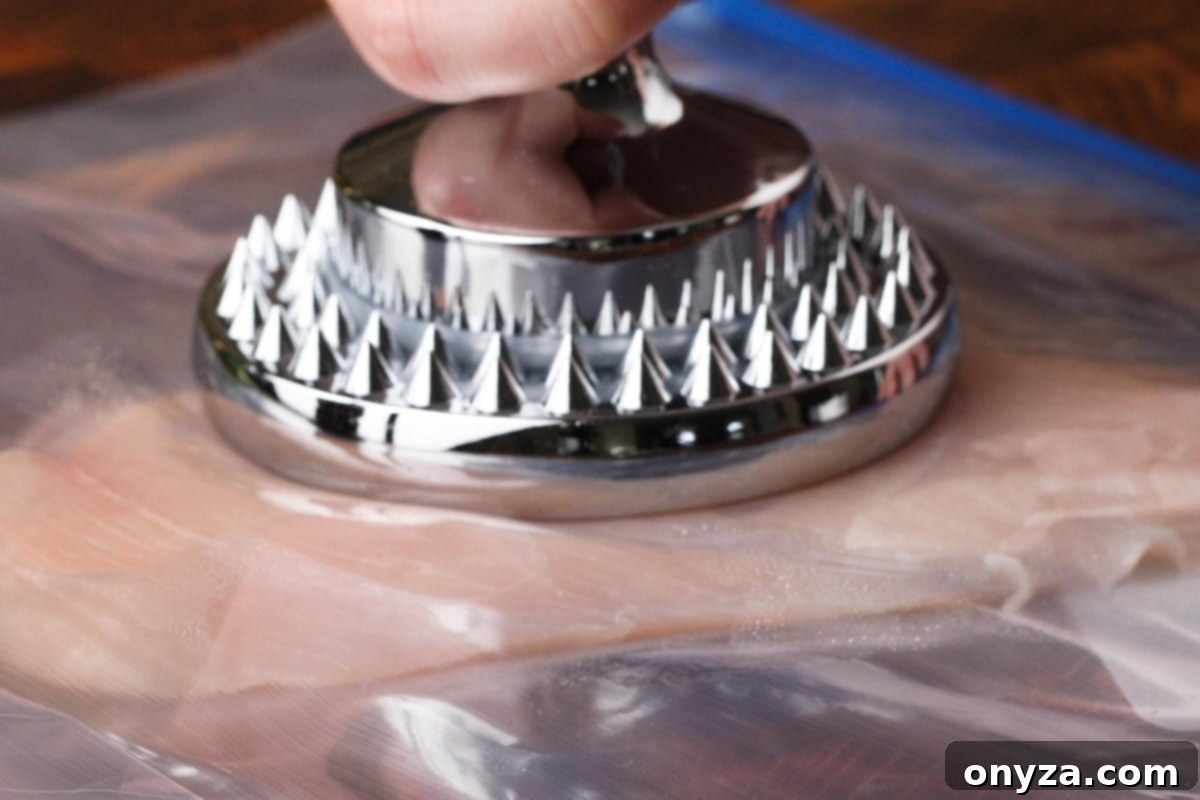
Using the flat side of a meat pounder or a rolling pin, work from the thickest part of the cutlet outwards, striking evenly and gently to avoid tearing the delicate meat. Once pounded, generously season both sides of the cutlets with kosher salt and freshly ground black pepper. This initial seasoning is crucial for building flavor from the inside out.
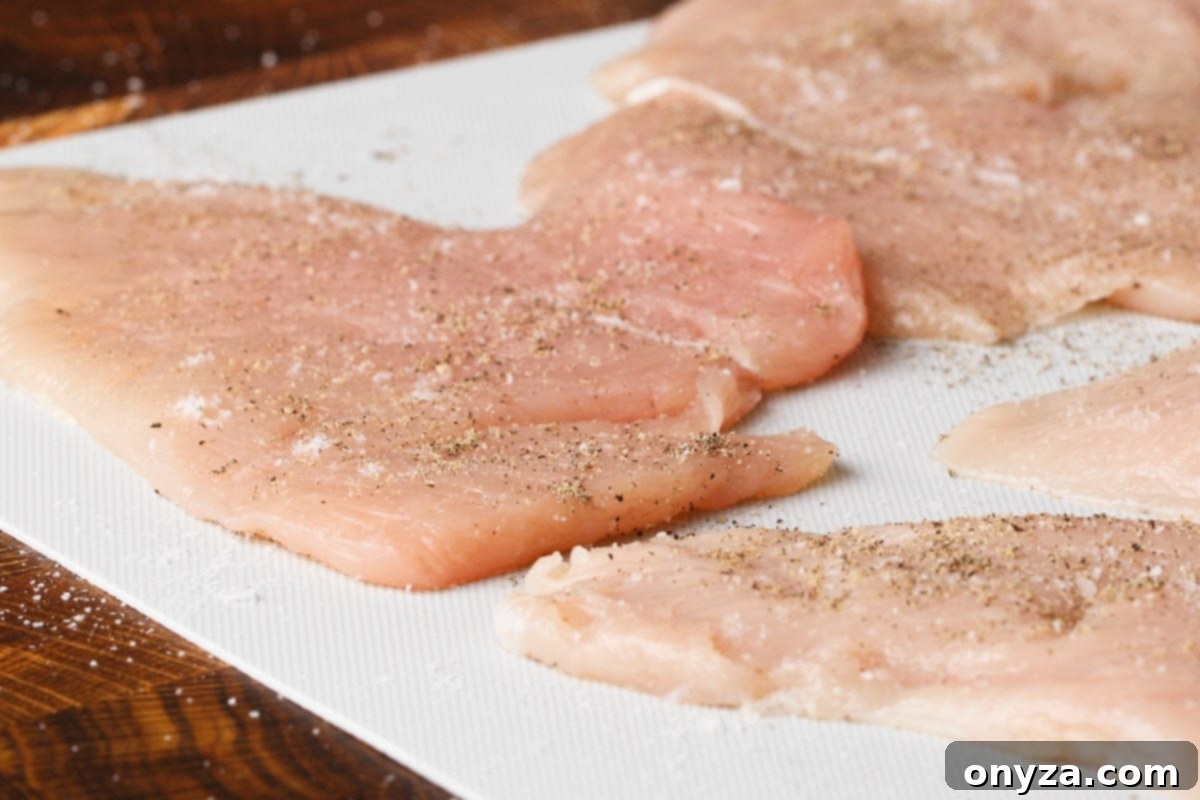
Step 2: Achieving a Golden-Brown Crust on the Chicken
Browning the chicken cutlets is a critical step that develops a deep, rich flavor through the Maillard reaction. This caramelization creates the foundation for your delicious Marsala sauce.
To ensure proper browning and prevent the chicken from steaming, it’s essential to sear the chicken in two batches. This provides ample space for each cutlet to make direct contact with the hot pan, allowing a beautiful crust to form. Dredge only half of the cutlets in all-purpose flour just before cooking them, shaking off any excess. This light coating helps achieve a golden exterior and contributes to thickening the sauce later.
Important Note: Avoid dredging all cutlets at once. If left to sit while the first batch cooks, the flour will absorb moisture from the chicken, becoming pasty and preventing a crisp crust.
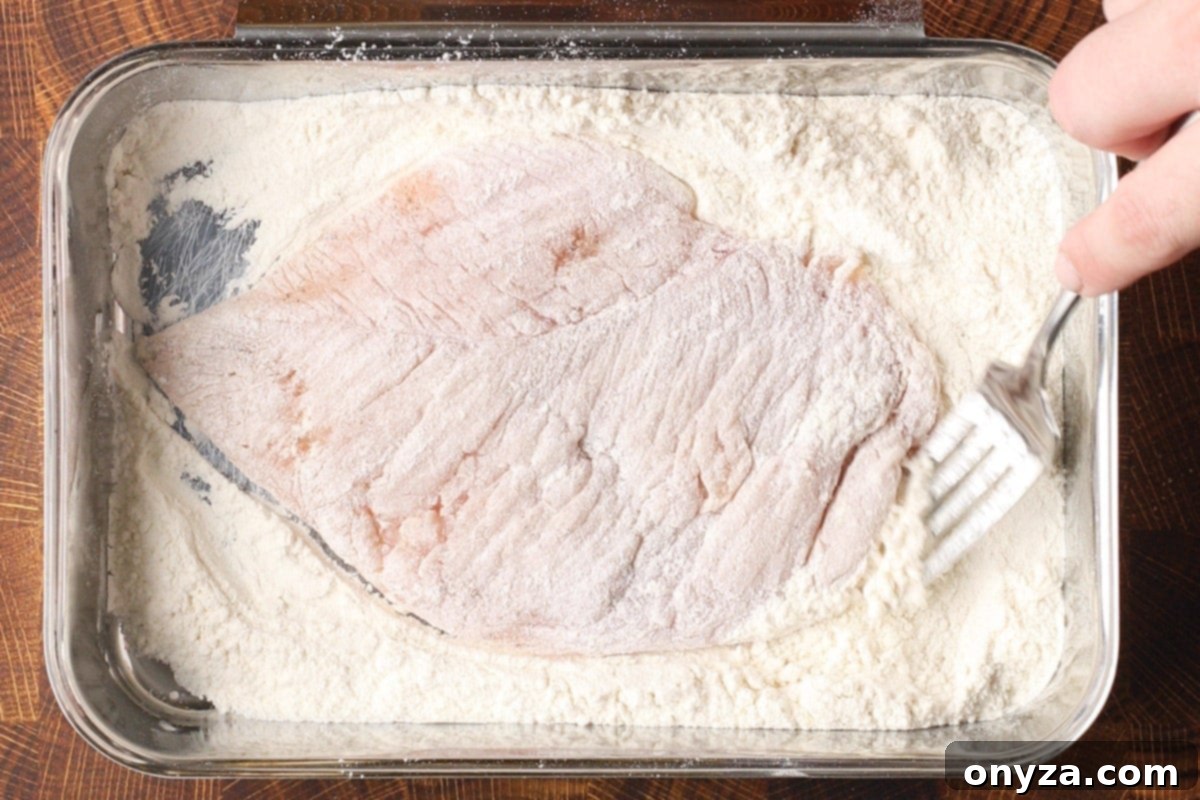
Heat a mixture of butter and olive oil in your large skillet over medium-high heat. Once hot, add the first batch of floured cutlets and cook for 2-3 minutes per side, until they are beautifully golden brown. At this stage, your goal is to build flavor and a crust, not to cook the chicken all the way through. The pan will develop flavorful caramelized bits (fond) – don’t worry, these will be incorporated into the sauce later!
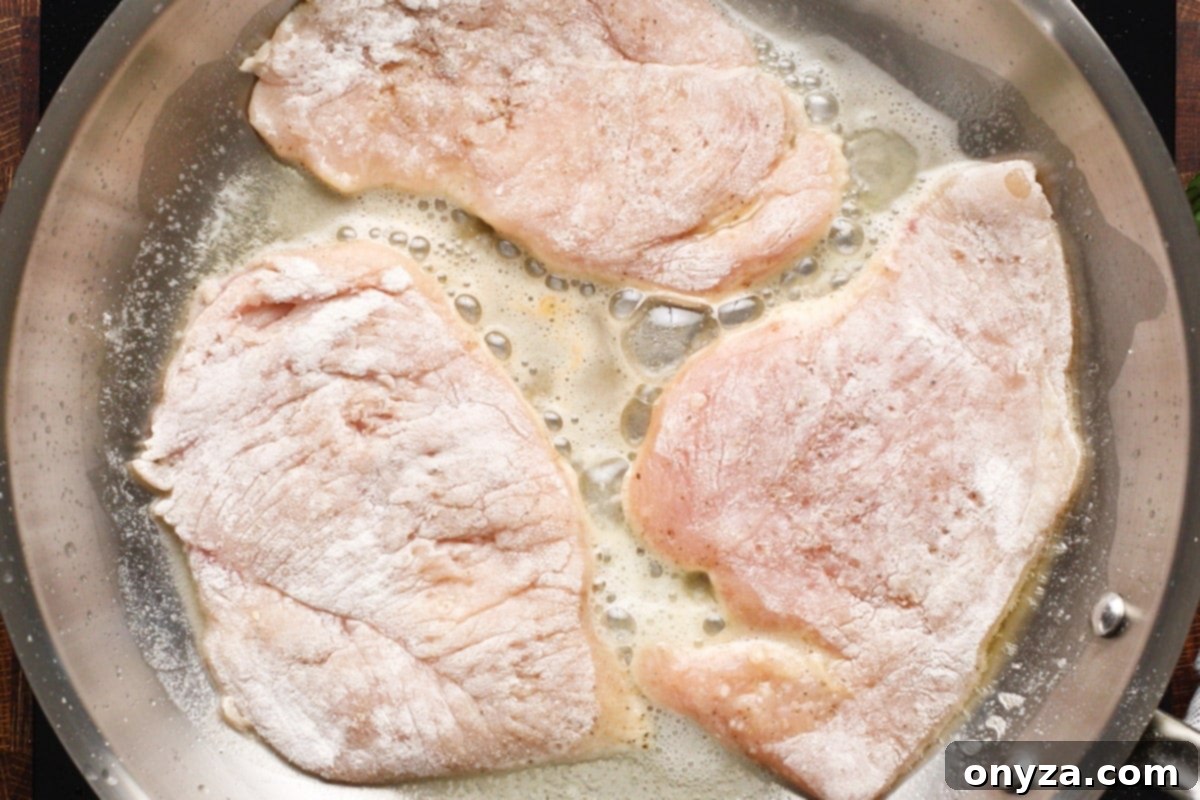
Carefully transfer the browned chicken cutlets to a clean plate and loosely tent them with foil to keep them warm while you repeat the dredging and frying process with the remaining chicken. This ensures all your chicken is perfectly seared.
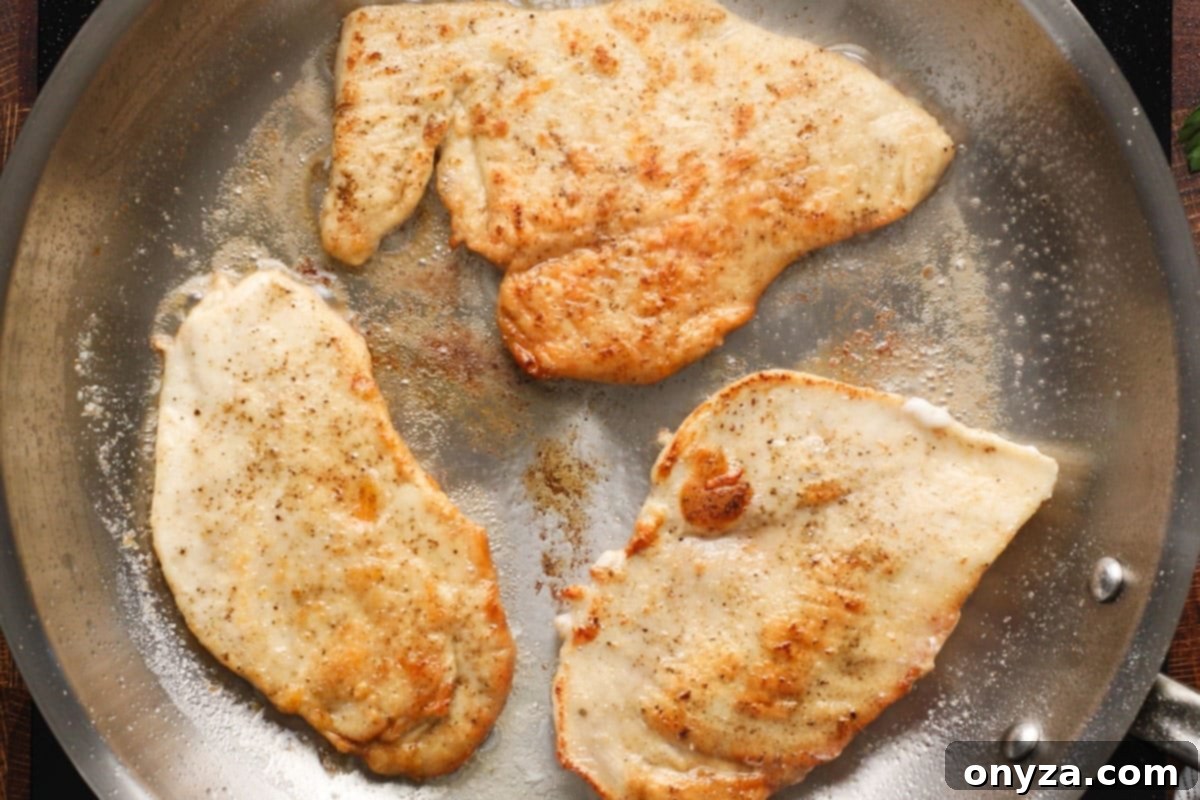
Step 3: Building Depth with Sautéed Mushrooms and Aromatics
With the chicken set aside, it’s time to build the next layer of flavor for your Marsala sauce. Add a little more butter and olive oil to the same pan – those delicious browned bits (fond) from the chicken are still there and will add incredible depth.
Toss in your sliced mushrooms and chopped shallots. Season them lightly with salt and pepper. Cook over medium-high heat, stirring occasionally, until the mushrooms release their moisture, the liquid evaporates, and they turn beautifully golden brown and tender. This typically takes about 5 to 8 minutes. Proper browning of the mushrooms is key to their earthy flavor.
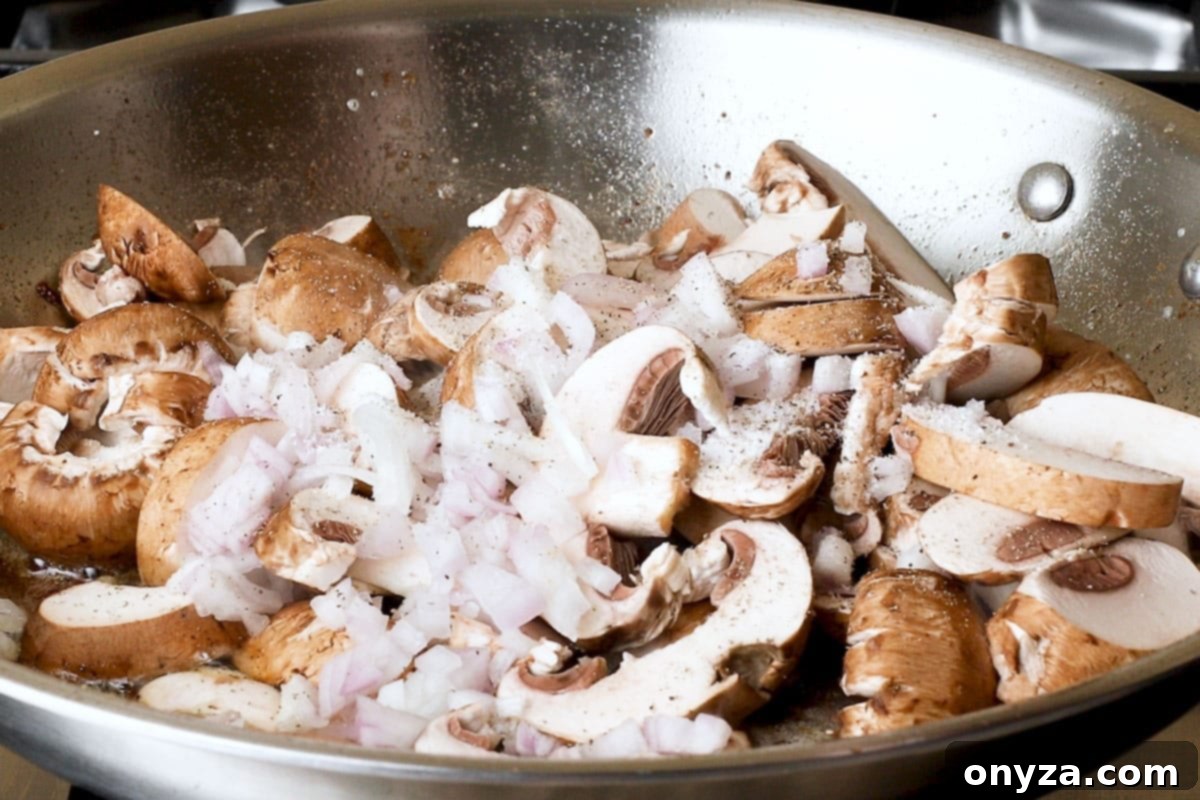
Finally, stir in the minced garlic. Garlic cooks quickly, so it only needs about 60 seconds in the hot pan—just long enough for it to become fragrant without burning. Burnt garlic can impart a bitter taste. Once fragrant, transfer the mushroom and shallot mixture to a separate plate, reserving it for later, and prepare to make your exquisite Marsala sauce.
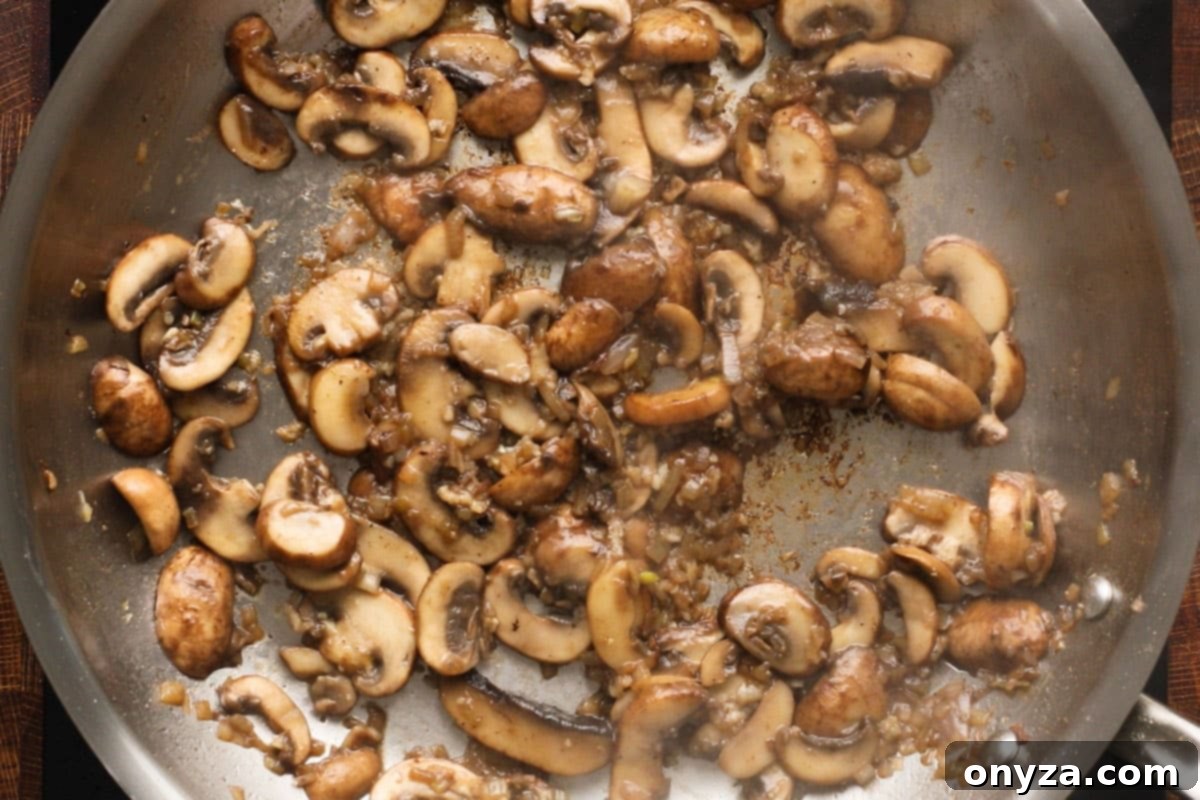
Step 4: Crafting the Rich Marsala Sauce
This step brings the star ingredient – Marsala wine – into play, creating the signature sauce that defines the dish. The deglazing process is crucial here, as it extracts all the flavorful caramelized bits from the bottom of the pan.
Remove the skillet from the heat briefly, then carefully pour in the Marsala wine. Return the pan to medium-high heat. Using a wooden spoon, diligently scrape up all the browned bits (fond) from the bottom and sides of the pan. These caramelized fragments from the chicken and mushrooms are packed with flavor and are essential for giving the sauce its incredible depth and complexity.
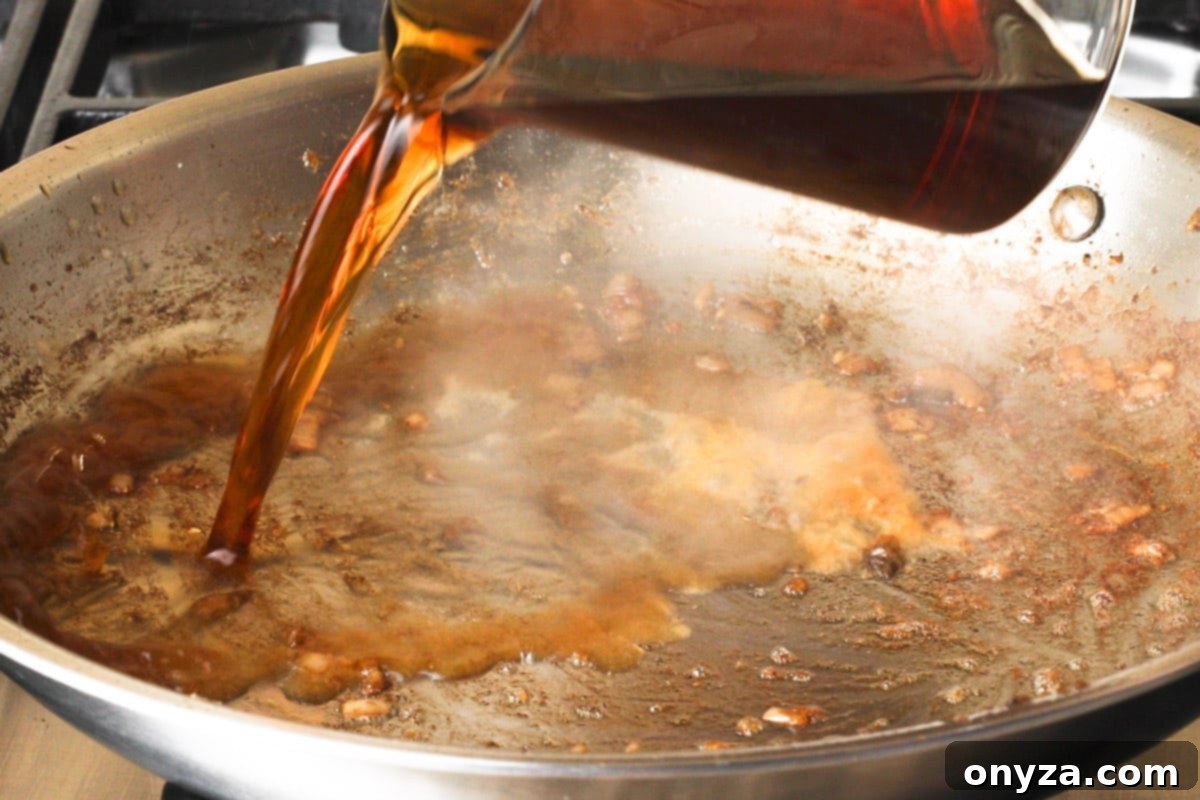
Allow the Marsala wine to vigorously simmer and reduce for approximately 2 to 3 minutes. This crucial reduction step concentrates the wine’s flavor and burns off most of the alcohol, leaving behind its distinct aromatic essence. Next, pour in the chicken stock. For best results and to control the overall saltiness of your dish, especially if you’re reducing the sauce significantly, opt for a lower-sodium chicken stock. Bring the mixture to a boil, then reduce the heat to a gentle simmer and let it cook for about 5 minutes, allowing the flavors to meld and the sauce to reduce slightly.
Once the sauce has reduced, carefully slide the browned chicken cutlets and the sautéed mushrooms back into the pan. Be sure to include any accumulated juices from the plate – these are pure flavor! Let everything simmer gently together for another 5 to 6 minutes. During this time, flip the chicken cutlets once or twice to ensure they are thoroughly coated and infused with the luxurious sauce, and to finish cooking them through. The sauce is ready when it has thickened slightly and beautifully clings to the back of a spoon.
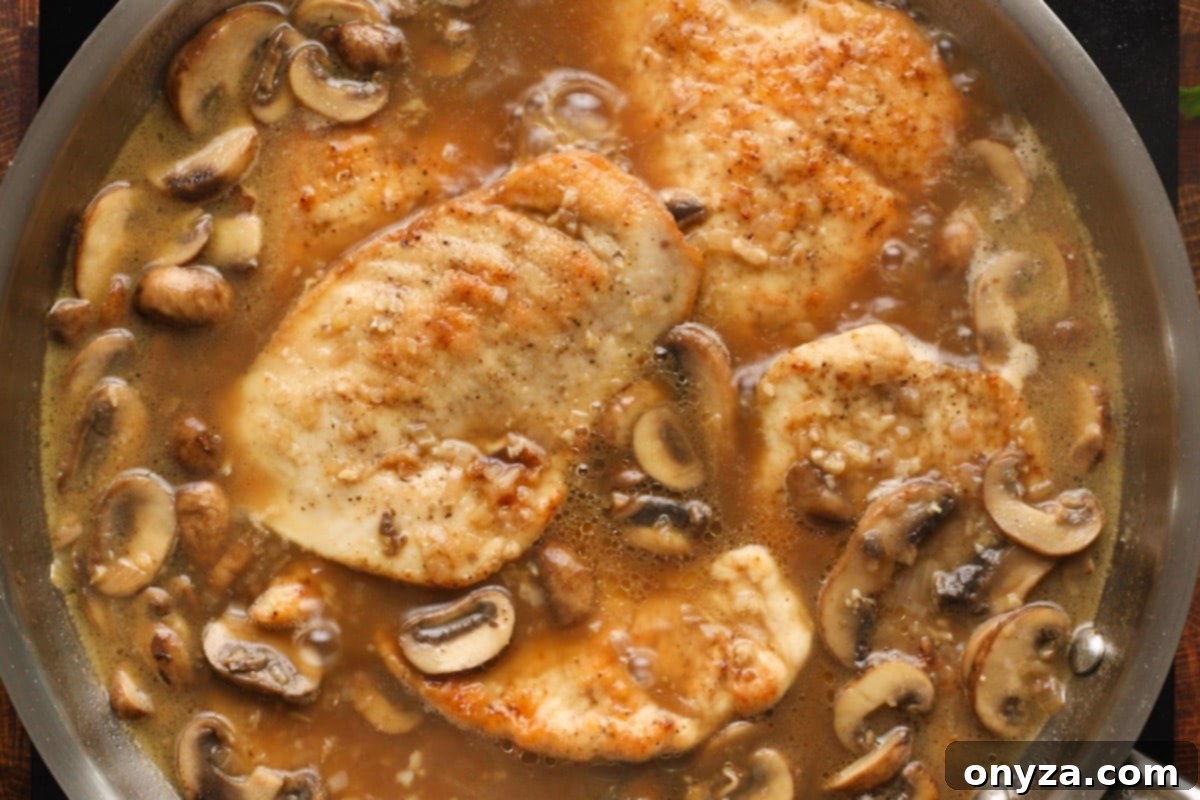
Step 5: Finishing Touches and Elegant Presentation
The final steps are all about refining the sauce and adding brightness to balance the rich, savory flavors. These touches elevate your Chicken Marsala to restaurant-quality perfection.
Carefully transfer the cooked chicken cutlets to a warm serving platter. Now, assess the consistency of your sauce. If it appears thinner than your desired texture, return the pan to the stove over medium-high heat and allow it to simmer for an additional minute or two. The sauce will thicken relatively quickly at this stage, so keep a close eye on it to prevent over-reduction.
Once the sauce reaches your preferred consistency, remove the pan from the heat. Swirl in a generous knob of remaining unsalted butter. This enriches the sauce, adding a glossy sheen and velvety texture. A squeeze of fresh lemon juice is vital here; its acidity brightens the deep, savory flavors of the Marsala and mushrooms, preventing the dish from tasting too heavy. Finally, stir in fresh chopped flat-leaf parsley for a burst of herbaceous freshness and vibrant color.
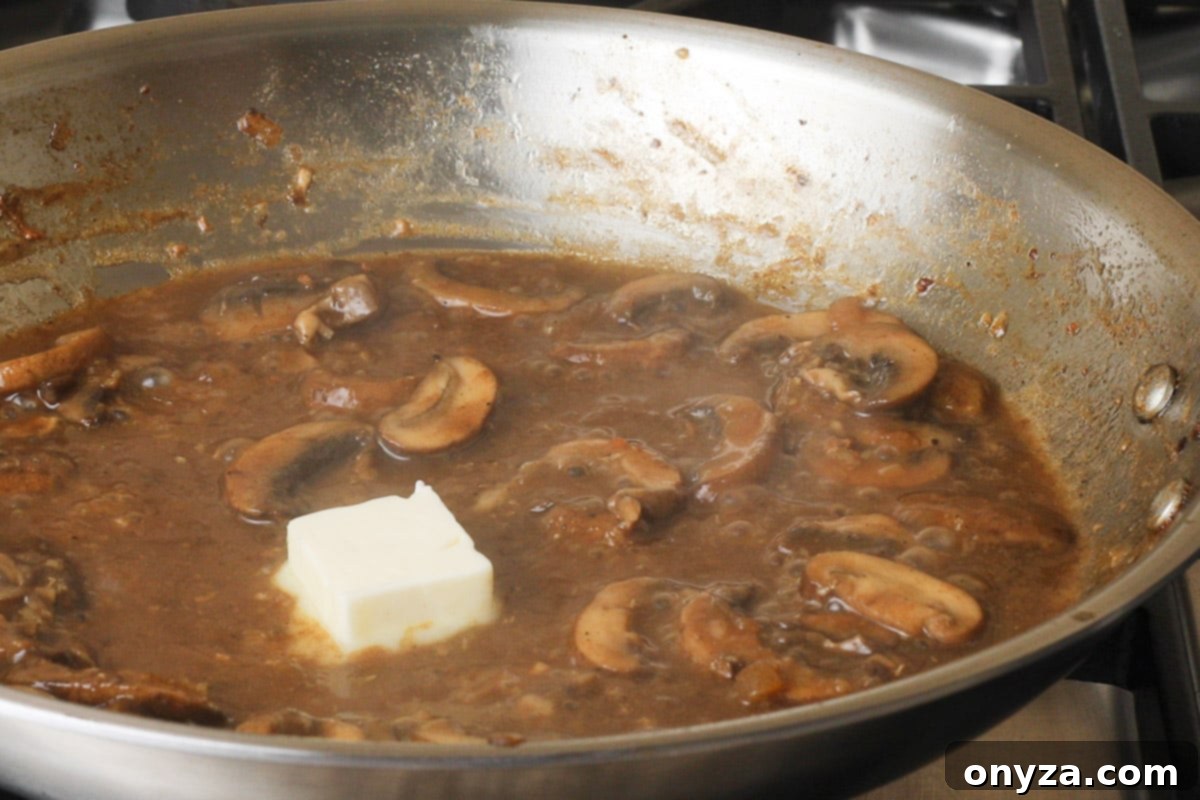
Taste the sauce and adjust the seasoning with additional salt and pepper if necessary. Spoon the luscious Marsala sauce and mushrooms generously over the chicken cutlets on the platter. For a final flourish, garnish with extra fresh parsley. Your homemade Chicken Marsala, a masterpiece of Italian-American cuisine, is now ready to impress at your dinner table.

Chef’s Insights: Perfecting Your Marsala Sauce
Many home cooks often inquire about making extra Marsala sauce, perhaps to toss with pasta or simply to have more of its delectable richness. While it’s certainly possible to scale up the sauce ingredients, there are a few important considerations to ensure the best results.
If you plan to double the sauce components, remember that a larger volume of liquid will naturally take longer to reduce to the desired consistency. Also, the flour coating from the chicken alone might not be sufficient to thicken a significantly increased batch of sauce. A good strategy for doubling the sauce is to allow the Marsala wine to reduce by at least half before introducing the chicken stock. Then, give the combined wine and stock a few extra minutes to simmer and concentrate its flavors before adding the chicken and mushrooms back to the pan. This prevents the chicken from overcooking while the sauce achieves its ideal thickness.
Should your sauce still appear thinner than desired after the chicken has finished cooking, a quick and effective solution is a cornstarch slurry. To prepare one, whisk together 1 tablespoon of cornstarch with 2 tablespoons of cool broth or water until smooth. Gradually stir this slurry into the simmering sauce, a splash at a time, allowing it to cook for a minute between additions. The sauce will thicken noticeably, providing that luxurious, clinging texture you desire without altering the flavor profile. Always add slowly and observe the change in consistency to avoid over-thickening.
Perfect Pairings: Elevating Your Chicken Marsala Experience
The luscious mushroom-Marsala sauce is undoubtedly the star of this dish, so choosing accompaniments that can soak up every last drop is key. Thoughtful pairings will transform your Chicken Marsala into a complete and unforgettable meal.
For a truly comforting experience, creamy mashed potatoes are a classic choice, their velvety texture providing a perfect canvas for the rich sauce. Other excellent options include buttered egg noodles, which are fantastic for swirling through the sauce, light and fluffy rice, or a bed of soft, cheesy polenta. Each of these options offers a delightful way to savor every bit of that incredible Marsala goodness.
No Italian-American meal is complete without a basket of crusty Italian bread. Its porous interior and firm crust are ideal for “scarpetta” – the delightful act of swiping up every last morsel of sauce from your plate. Don’t underestimate the simple pleasure this provides!
To balance the inherent richness of Chicken Marsala, incorporating a fresh green side is highly recommended. Crisp-tender haricots verts (thin green beans), simply sautéed spinach with a hint of garlic, or roasted asparagus spears all provide a wonderful textural contrast and a refreshing counterpoint to the savory sauce.
If you’re planning Chicken Marsala for a dinner party, consider starting the meal with a light, simple starter salad. A vibrant arugula salad with a bright lemon vinaigrette, for example, offers a palate-cleansing beginning that perfectly sets the stage for the richer main course.
When it comes to wine pairings, a well-chosen glass can further enhance the dining experience. A medium-bodied Chardonnay, particularly one that’s unoaked or lightly oaked, complements the creamy and earthy notes of the dish beautifully. For red wine enthusiasts, a light-bodied red such as a Pinot Noir or a less tannic Chianti offers a pleasant contrast, harmonizing with the mushrooms and the savory Marsala sauce without overpowering the delicate chicken.

Explore More Delicious & Easy Chicken Dinners
If you thoroughly enjoyed the rich flavors and straightforward preparation of this Chicken Marsala, you’re in for a treat! Here are a few more reader-favorite chicken recipes that are sure to inspire your next meal:
- Chicken Milanese – Golden-crisp, pan-fried chicken cutlets served with a refreshing, vibrant arugula salad.
- Roasted Chicken with Root Vegetables – A comforting and hearty one-pan dinner, perfect for chilly evenings, featuring tender chicken and caramelized root vegetables.
- Mushroom and Goat Cheese Stuffed Chicken Breasts – An elegant dish that’s surprisingly easy to prepare, making it ideal for entertaining guests or a sophisticated weeknight meal.
- Hard Cider Chicken with Bacon and Apples – A unique sweet and savory braised chicken dish, particularly delightful for the autumn season.
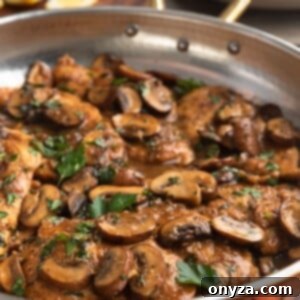
Rating: 4.60 out of 5 stars (based on 5 votes)
Chicken Marsala
By: Amanda Biddle
Chicken Marsala is an easy, restaurant-quality scallopini dish that’s great for a weeknight or for a dinner party. Ready in an hour, prep to table!
Prep Time: 20 minutes
Cook Time: 40 minutes
Total Time: 1 hour
Yields: 3 to 4 servings
Ingredients
- 1-1/4 pounds thinly-sliced chicken breast cutlets (about 6-7 cutlets; see note on preparing chicken)
- 3 tablespoons olive oil (not extra virgin), divided
- 4 tablespoons unsalted butter, divided
- ¼ cup all-purpose flour
- 10 ounces sliced mushrooms (cremini recommended)
- ⅓ cup chopped shallot (about 1 large)
- 2 large garlic cloves, minced
- 1 cup dry Marsala wine (ensure it’s not “cooking wine”)
- ¾ cup chicken stock (opt for lower-sodium; see note)
- 1 teaspoon freshly-squeezed lemon juice
- 2 tablespoons chopped flat-leaf parsley
- Diamond Crystal kosher salt and freshly-ground black pepper, to taste
Instructions
Prep the Chicken
- Pound the chicken cutlets to an even ¼-inch thickness. If starting with whole boneless, skinless chicken breasts, slice them in half horizontally first before pounding.
- Season both sides of the pounded cutlets generously with salt and pepper.
Brown the Chicken
- Heat 1 tablespoon olive oil and 1 tablespoon unsalted butter in a large (12–14-inch) skillet over medium-high heat.
- Lightly dredge half of the seasoned cutlets in flour, shaking off any excess. Cook for 2–3 minutes per side until golden brown. Transfer to a plate and tent with foil.
- Repeat the browning process with the remaining cutlets, adding an additional 1 tablespoon each of olive oil and butter to the pan. Add them to the plate with the first batch.
Sauté the Mushrooms
- Add another 1 tablespoon each of olive oil and butter to the empty pan.
- Sauté the sliced mushrooms and chopped shallots with ½ teaspoon salt and ¼ teaspoon pepper. Cook for about 5–8 minutes, until they brown and their liquid evaporates.
- Stir in the minced garlic and cook for 1 minute until fragrant. Transfer the mushroom mixture to a plate.
Make the Sauce
- Remove the pan from the heat and pour in the Marsala wine. Return to medium-high heat and deglaze the pan, scraping up all the browned bits from the bottom. Let the wine boil and reduce for 2–3 minutes.
- Stir in the chicken stock, bring to a boil, then reduce to a simmer and cook for about 5 minutes until slightly reduced.
Finish Cooking the Chicken
- Return the browned chicken cutlets and sautéed mushrooms (along with any accumulated juices) to the pan, nestling them into the simmering sauce.
- Simmer gently for 5-6 minutes, turning the chicken occasionally, until the chicken is cooked through and the sauce lightly coats the back of a spoon.
Finish the Dish
- Transfer chicken to a warm platter. If needed, simmer the sauce for an additional 1-2 minutes to thicken.
- Off the heat, stir in the remaining 1 tablespoon unsalted butter, fresh lemon juice, and half of the chopped parsley.
- Taste the sauce and adjust seasoning as needed. Spoon the sauce and mushrooms over the chicken. Garnish with the remaining parsley and serve immediately.
Notes
Chicken Preparation: If you’re starting with whole boneless, skinless chicken breasts instead of pre-cutlets, slice them horizontally to create two thinner fillets before pounding them to ¼-inch thickness. Refer to Step 1 in the main blog post for detailed instructions.
Chicken Stock: When using store-bought chicken stock, choose a lower-sodium variety to prevent the final sauce from becoming overly salty. A good benchmark is a stock with around 440 mg of sodium per cup.
Nutrition Estimate
Nutrition information is automatically calculated and should be used as an approximation.
- Serving: 0.3 recipe
- Calories: 528 kcal
- Carbohydrates: 22 g
- Protein: 35 g
- Fat: 26 g
- Saturated Fat: 10 g
- Cholesterol: 122 mg
- Sodium: 243 mg
- Potassium: 929 mg
- Fiber: 2 g
- Sugar: 8 g
- Vitamin A: 561 IU
- Vitamin C: 8 mg
- Calcium: 28 mg
- Iron: 2 mg
About Our Recipes
Please note that our recipes have been developed using the US Customary measurement system and have not been tested for high altitude/elevation cooking and baking.
Like this? We’d love to hear from you! Rate and comment on the recipe below to share your experience!
Editor’s Note: This recipe was first published on Striped Spatula in September 2020. This post has been updated with improved copy, enhanced details, and additional process photos to better serve our readers.
